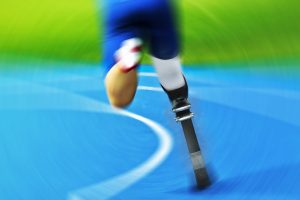Background
Amputation is an acquired condition that results in the loss of a limb, typically from disease, injury, and/or surgery. There are approximately 278,000 new amputees each year in the United States (Amputation statistics, 2012). Seventy-seven percent of these cases are from circulatory problems, particularly peripheral vascular disease (PVD) related to diabetes, while most of the rest are due to trauma.
Warning Signs
Most amputations involve the lower limbs, above or below the knee. The greatest risk factor for amputation is diabetes with peripheral vascular disease, with African American men having a 2.3 times greater rate of amputation than Whites with diabetes. Advanced age and the incidence of diabetes in the elderly make this a potential problem in the older age group. Additionally, a recent study showed that HgbA1c level was a significant predictor of foot amputation (Palmer, et al,et al., 2011).
Diagnosis
In the acute phase of recovery after surgery, it is important to prevent contractures of the knee joint and maintain normal muscle power and range of motion in remaining joints. The limb should not be hung over the bedside or placed in a dependent position. Both in acute care and rehabilitation, the stump should be conditioned to prepare for the wearing of a prosthesis (an artificial limb). In certain cases, an older person may choose, after speaking with the doctor, not to wear a prosthesis. But, this is usually only when there are other health problems, such as poor balance from another disease or disorder that would make falling and injury more likely with the use of an artificial limb.
Treatment
Initially, there may be drainage from the surgical site, and a sterile dressing will be kept in place and changed at least daily. Eventually, the staples or sutures will be removed and a thick, black eschar (like a hard, dark scab) will form at the amputation site and gradually come off. An Ace wrap or stump shrinker sock (elastic) is used to help prepare the stump for wearing a prosthesis. Several factors should be considered when preparing the stump to wear this artificial limb. These include a movable scar, lack of tenderness/sensitivity, a cone shape, firm skin, and minimizing any swelling. All of these can be achieved by proper wrapping of the stump. The prone position (laying on the stomach), if tolerable, is an excellent way to promote full extension of the residual limb.
It is also important for the person to begin therapy right away. Persons wearing a prosthesis use more energy to walk. An older person with an artificial leg generally has a 40% decrease in speed but uses 80% more energy to walk than the average healthy adult (Chinn et al, 2005).
When using the prosthesis at first, an older adult may tire easily. Be sure to take into account any coexisting problems, such as heart of lung disease, when considering energy expenditure. However, the newest technologies allow prosthetics to be light, durable, and more comfortable.
Patients and families will need to learn about stump care, mobility, adaptation, coping, and self-care. Home maintenance, dealing with complications and/or additional health problems, wear and tear on non-weight-bearing joints, adapting to the environment, accessibility, stigma, depression, role changes, decreased energy, and chronic pain are all issues to be aware of related to amputation. It is likely that the person with a leg amputation will experience some shoulder problems over time due to the additional stress on the non-weight-bearing joints. Phantom limb pain, or pain sensations in the nonexistent limb, is more common after traumatic amputations and may last for weeks after amputation. Massage and medications may help with this type of pain control (Beers, 2005). Additionally, proper wrapping of the stump (in a figure-eight wrap) may help decrease the chance of phantom limb pain later (Kalapatapu, 2012). Also, people with an amputation may struggle with difficult feelings about the changed appearance of their body. They might worry if their spouse or loved ones will see them differently. They might fear what others will think and worry about getting their life back to what feels normal.
In general, older persons with amputation may return to a normal quality of life with some adaptations. The care provided by nurses and physicians in rehabilitation after amputation may make the difference in the person’s ability to cope with the changes that result after surgery. Nurses can help with the transition back into the community after amputation by educating patients and families about resources to assist with adaptation.
Adapted from Mauk, K. L., Hanson, P., & Hain, D. (2014). Review of the management of common illnesses, diseases, or health conditions. In K. L. Mauk’s (Ed.) Gerontological Nursing: Competencies for Care. Sudbury, MA: Jones and Bartlett Publishers. Used with permission.
[call_to_action title=”For More Information Visit” tag_line=”Amputee Coalition” arrow=”yes”]
http://www.amputee-coalition.org/
Download this care page as a PDF: Amputationkme
[/call_to_action]

